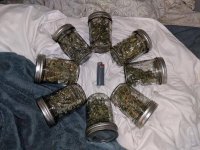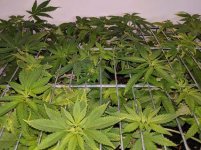Shout out to the micro forum, coco forum, sub-irrigators, there's a lot of good stuff in there. Also, The Potcast. And lots of others.
I have some back logs of photos and observations on growing errors I've made. Hopefully this can help somebody debug their grow
Very few of these observations will be original. Thanks to everyone who has grown before.
In my model, there are some basic categories of error:
Genetics
Substrate
Irrigation
Atmosphere
Light
Training
Preserving
And things to consider with each of these are
And the objectives that we are seeking to affect are
Something that DJ Short says is that it's about the final effect of the medicine. Tea (camillia sinensis) cultivators produce a broad range of flavors and effects from the same plant based on differing growth conditions and physical processing. Whether leaves are shredded finely for black tea, rolled into balls or spears for oolong tea, left to dry undamaged, grown out into broad leaves or picked early as small buds, the shape of the plant at harvest determines some initial chemical conditions and the shape during oxidation and storage determines, among other things, surface area to volume ratios which affect the short and long term evolution of the chemical conditions in the final product.
Similarly, bud density on the plant affects trichome quantity and development. Super dense buds that don't have room for proper trichome development will crush the glands more readily even during growth, changing the profile at harvest as well as the curing dynamics.
Increasing total bud mass might push buds in one habit or structure into the super dense regime, but not others.
Increasing total resin content might disproportionately increase one terp over another, which might be undesirable. Perhaps increasing total resin by one mechanism simply adds limonene or pinene, masking a rare flavor in a strain. Terp ratios change the effect of the herb. Some herb may paradoxically become trippier if its resin contents is decreased.
Different terps evaporate at different rates, and spectrum probably affects expression. This means that different lights and atmospheric conditions will change these ratios. And perhaps most critically, drying and curing. It is said time and again, preservation is one of the most crucial stages because during the course of 2 weeks of drying and curing you are risking months of bud growth and resin development in order to purge water from your buds so that they will keep safely.
Every decision you make during preservation processes has a larger effect per unit time than decisions made during growing, and so I make sure to check on my drying and curing buds about four times as often as my drying buds. It takes a lot of time to grow resin, but you can lose it in a jiffy.
This thread is all about avoiding errors and manipulating our four flower objectives in order to achieve a desired ultimate effect.
I have some back logs of photos and observations on growing errors I've made. Hopefully this can help somebody debug their grow
Very few of these observations will be original. Thanks to everyone who has grown before.
In my model, there are some basic categories of error:
Genetics
Substrate
Irrigation
Atmosphere
Light
Training
Preserving
And things to consider with each of these are
Amount
Frequency
Frequency
And the objectives that we are seeking to affect are
Flower Mass
Flower Structure
Total Resin Content
Specific Resin Content
Flower Structure
Total Resin Content
Specific Resin Content
Something that DJ Short says is that it's about the final effect of the medicine. Tea (camillia sinensis) cultivators produce a broad range of flavors and effects from the same plant based on differing growth conditions and physical processing. Whether leaves are shredded finely for black tea, rolled into balls or spears for oolong tea, left to dry undamaged, grown out into broad leaves or picked early as small buds, the shape of the plant at harvest determines some initial chemical conditions and the shape during oxidation and storage determines, among other things, surface area to volume ratios which affect the short and long term evolution of the chemical conditions in the final product.
Similarly, bud density on the plant affects trichome quantity and development. Super dense buds that don't have room for proper trichome development will crush the glands more readily even during growth, changing the profile at harvest as well as the curing dynamics.
Increasing total bud mass might push buds in one habit or structure into the super dense regime, but not others.
Increasing total resin content might disproportionately increase one terp over another, which might be undesirable. Perhaps increasing total resin by one mechanism simply adds limonene or pinene, masking a rare flavor in a strain. Terp ratios change the effect of the herb. Some herb may paradoxically become trippier if its resin contents is decreased.
Different terps evaporate at different rates, and spectrum probably affects expression. This means that different lights and atmospheric conditions will change these ratios. And perhaps most critically, drying and curing. It is said time and again, preservation is one of the most crucial stages because during the course of 2 weeks of drying and curing you are risking months of bud growth and resin development in order to purge water from your buds so that they will keep safely.
Every decision you make during preservation processes has a larger effect per unit time than decisions made during growing, and so I make sure to check on my drying and curing buds about four times as often as my drying buds. It takes a lot of time to grow resin, but you can lose it in a jiffy.
This thread is all about avoiding errors and manipulating our four flower objectives in order to achieve a desired ultimate effect.
Last edited:





































